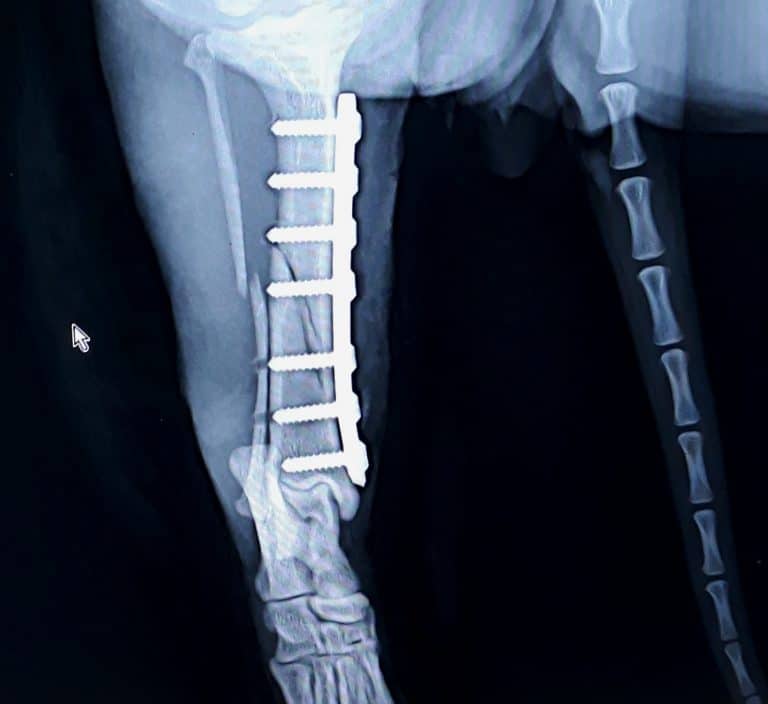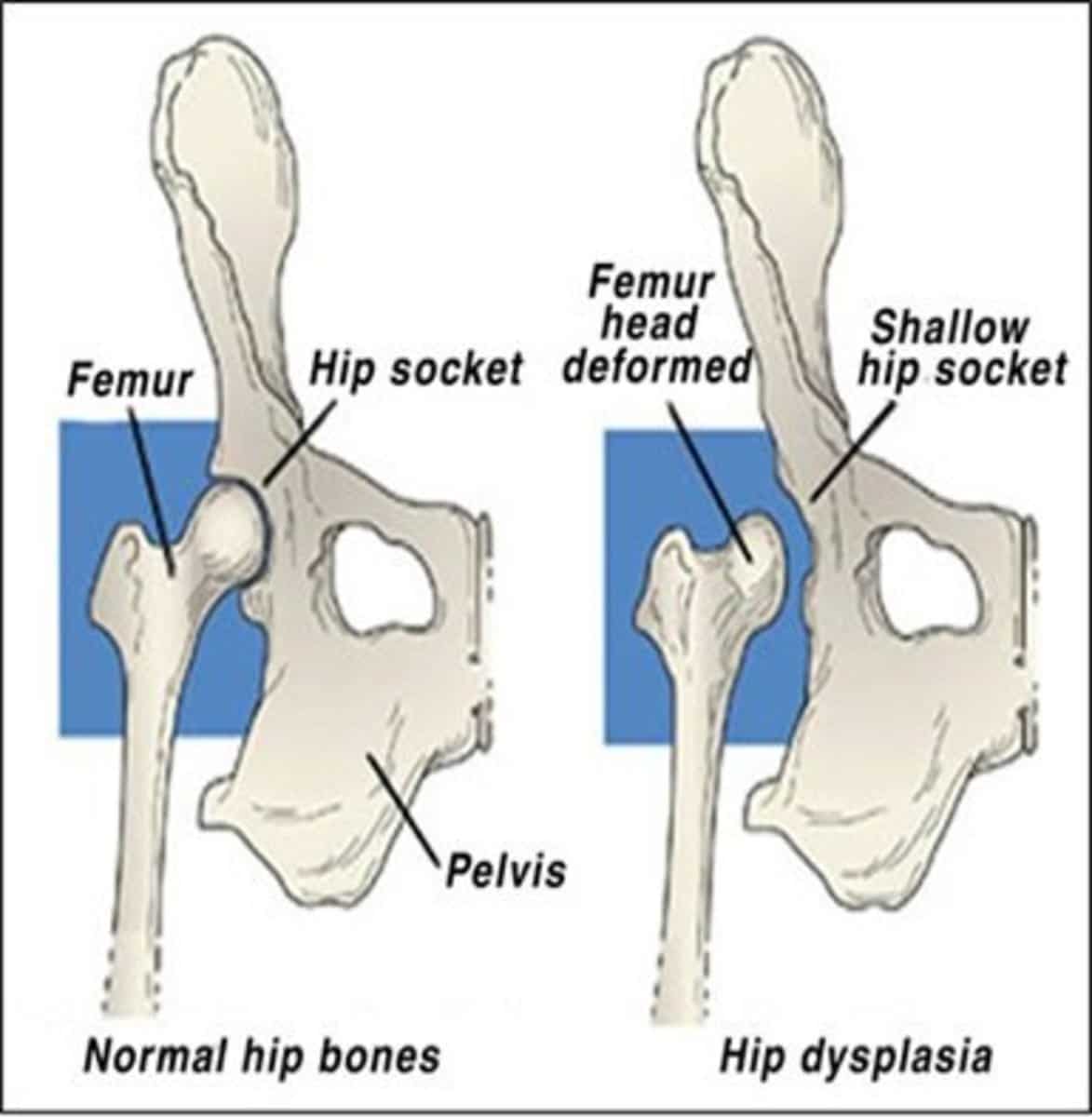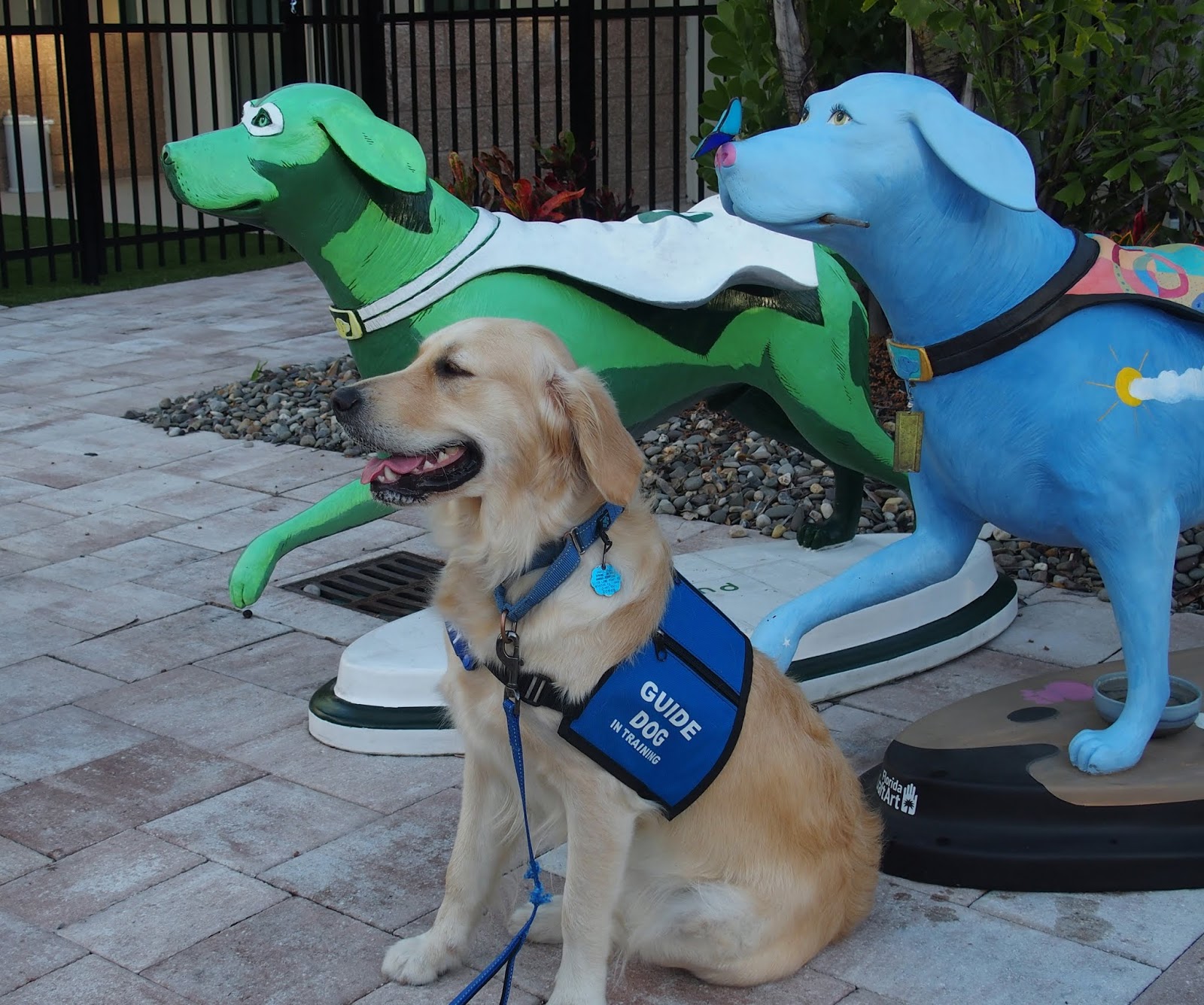The Institute Of Canine Biology
2) The genes that cause hip dysplasia remain a mysteryassociatedcause3) Environmental factors are also important4) Joint laxity is the primary cause of hip dysplasia
| In dogs as well as many other vertebrates , the head of the femur in newborns is held securely in place by a strong ligament variously called the “round ligament” or “teres ligament”.One end of this ligament is attached to the head of the femur and the other end to the inner wall of the acetabulum .You can see the teres ligament in this illustration . |
5) Controlling joint stability is key“The teres ligaments of the hip joints were edematous , a few ligament fibers were torn, and capillary hemorrhage dotted the surface of the ligaments at the point of the tears. These changes were considered the first findings that might be linked to hip dysplasia.”“6) Body weight is a MAJOR environmental factor
| Puppies that weigh more at birth as well as those with higher growth rates have a higher risk of degenerative changes in the hip joint .As this graph shows, puppies kept on a restricted diet have a dramatically lower risk of dysplasia and it develops much later in life than in puppies kept on normal rations . |
the incidence of hip dysplasia in dogs could be immediately and dramatically reduced simply by practicing better weight management7) Exercise is good and bad8) Nutrition is importantnot9) Early intervention is criticalmust10) We can dramatically reduce hip dysplasia now* Revised 13 Dec 2015
Loss Of Muscle In The Thigh
As the hip dysplasia condition progresses, dogs will not use their thigh muscles nearly as much, especially when it comes to running and jumping. This will, in turn, lead to an atrophy of the muscles in the thighs. The loss of muscle will eventually become noticeable visually, especially if hip concerns are left untreated.
This is another symptom that is not usually associated with many other conditions. If you notice this symptom in your dog, you have likely already seen some of the others listed here before he has gotten to this point of muscle atrophy.
Exercise And Physical Therapy
Daily exercise is important to maintain a lean physique, but should be performed in moderation. This means that jumping, running, and agility courses can aggravate hip dysplasia. Physical therapy is another way to stay healthy because it improves limb usage through deep tissue massage, passive range of motion exercises, and other modalities. Physical therapy helps to maintain muscle strength in the hips, legs, and lower back. Cold laser therapy and acupuncture have also been shown to provide relief from hip pain and improved range of motion.
Also Check: How Big Does A Golden Retriever Lab Mix Get
Treatment For Hip Dysplasia
These are the most common forms of treatment that your veterinarian will order for helping the Golden Retriever, or other breeds of dogs. These treatments range from lifestyle changes to surgery. Surgery is of course dependent on the financial aspects of the owner and also if the dog is a good candidate for the treatment option of surgery.
The other treatment options include the following:
- Weight reduction, which takes the stress off the joints and especially the hips
- Restriction of exercise, and definitely not on hard surfaces
- Physical therapy
- Joint supplements, such as Glucosamine
- Anti-inflammatory medication and corticosteroids
- Joint fluid modifiers
For the Golden Retrievers or dogs that are good candidates for surgery, there are a few different options. Double or triple pelvic osteotomy this is a surgery that would be performed on the canines less than 10 months old. It involves cutting the pelvic bone and rotating the hip joint as needed.
Femeral head osteotomy
Femoral head osteotomy is a surgery that can be performed on young or mature dogs. This is more detailed as the hip ball joint is cut off and removed. This does not return movement back to normal, but it does provide more movement with less pain.
Hip replacement
How To Screen My Dog For Hip Dysplasia

A single submission to the Hip Scheme starts from £70.00. A full breakdown of costs and offers can be found on our Submissions Fees page.
Recommended Reading: Golden Retriever Puppies Boulder Colorado
Clinical And Pathological Effects
Hip dysplasia is a disease of the hip joints. Dysplasia means abnormal development. Both hips are usually affected . It is a complex disease that results from a combination of genes that predispose a dog to developing hip dysplasia interacting with environmental factors that lead to its full development and expression . It is characterized by hip joint instability which, if compounded by environmental factors, then results in secondary osteoarthritis and the clinical signs of hip dysplasia which include pain, lameness and disability .
Hip dysplasia is described as a biomechanical disease. The hips appear normal at birth. However, in affected individuals, the hips develop abnormally due, at first, to joint instability . This means that the developing femoral head and acetabulum are not held constantly, closely together, and can move into abnormal positions relative to one another. This puts abnormal stresses and strains on the joint. Riser states this is due to the soft tissues, such as ligaments and muscle, not being strong enough to maintain congruity between the articular surfaces of the femoral head and the acetabulum ie the constant contact between the surfaces of the bones is not maintained.
Joint laxity can lead on to joint subluxation that in turn causes flattening of the acetabular cup and femoral head . The pathological changes seen due to the joint instability are progressive inflammation and degeneration of the tissues that together form the joint.
Signs And Symptoms Of Hip Dysplasia
Dogs with hip dysplasia may show the following symptoms: difficulty getting up, climbing stairs, jumping, or performing other physical exercises. They may also become lethargic or show a decrease in activity. Dogs with hip dysplasia often exhibit a narrow, bunny hopping gait and you may hear grating sounds in their hip area during exercise. Pain, joint looseness, lameness, and loss of muscle mass are also possible. If you suspect that your dog is showing signs of canine hip dysplasia, the first step is to consult with a veterinarian.
You May Like: Red Golden Retriever Puppies Az
Petietec Heating Therapy Braces
PetieTec Targeted Heating Therapy Braces are specially designed for our furbabies joint issues. They can not only be used for easing the pain from arthritis and hip dysplasia, but also for relaxing and stimulate blood circulation after exercise.
Veterinarian approved Targeted Heating & 3 Temperature options Different sizes for different breeds Made of Graphene material without over heating Totally safe with no sided effects Work well with other therapies
Hip Dysplasia In Golden Retrievers
When you own a Golden retriever, it is important to know about common illnesses that could potentially affect your pup. Problems like ear and skin issues can vary in their degree of intensity, but few disorders can negatively impact quality of life the way that hip dysplasia can.
You May Like: Golden Retriever Rescue Richmond Va
Golden Retriever Study Suggests Neutering Affects Dog Health
Neutering, and the age at which a dog is neutered, may affect the animals risk for developing certain cancers and joint diseases, according to a new study of golden retrievers by a team of researchers at the University of California, Davis.
The study, which examined the health records of 759 golden retrievers, found a surprising doubling of hip dysplasia among male dogs neutered before one year of age. This and other results were published Feb. 13 in the online scientific journal PLOS ONE.
The study results indicate that dog owners and service-dog trainers should carefully consider when to have their male or female dogs neutered, said lead investigator Benjamin Hart, a distinguished professor emeritus in the UC Davis School of Veterinary Medicine.
It is important to remember, however, that because different dog breeds have different vulnerabilities to various diseases, the effects of early and late neutering also may vary from breed to breed, he said.
While results of the new study are revealing, Hart said the relationship between neutering and disease-risk remains a complex issue. For example, the increased incidence of joint diseases among early-neutered dogs is likely a combination of the effect of neutering on the young dogs growth plates as well as the increase in weight on the joints that is commonly seen in neutered dogs.
In Europe, however, neutering is generally avoided by owners and trainers and not promoted by animal health authorities, Hart said.
Hip Dysplasia Treatment Options
Once osteoarthritis is present on a radiograph, dysplastic changes are irreversible and usually continue to progress over time. If a dysplastic dog has secondary arthritis and pain, most owners elect to first treat their dog with medical management. The key is weight control and exercise. Studies have shown that up to 76% of severely dysplastic dogs with arthritis secondary to Hip Dysplasia are able to function and live comfortable, quality lives with conservative management. With weight control, the goal is to prevent the dog from becoming overweight to reduce mechanical stresses applied to the hip joints. In general terms, the ribs should be easily palpated and there should be an indentation in front of the pelvic wings .
Keep the dog in a warm environment. Warmth tends to help control the pain of arthritis from Hip Dysplasia. As in people, the arthritic pain in dogs tends to be worse in the damp and cold of winter. Providing a well-padded and warm bed will help alleviate some of the pain associated with osteoarthritis. An egg-crate foam bed for dogs is commercially available. Applying superficial heat in the form of heating pads may also relieve pain. Care must be taken not to burn the skin, especially with an electric heating pad. Heat works best for chronically inflamed joints from arthritis while cold works better to treat acute types of joint injury.
Also Check: Golden Retriever Puppies Harrisburg Pa
Treating Hip Dysplasia In Dogs
The good things is that there are various treatment options available for treating hip dysplasia in dogs including lifestyle modifications for mild cases and surgery for severe cases.
The non-surgical approach to be used largely depends on your dogs case and may include the following:
- Exercise restriction
If your dog is a good candidate for surgery, there are a few options which include:
- Double or triple pelvic osteotomy
- Femoral head ostectomy
- Total hip replacement
Your vet will determine which course of treatment is the best suited for your furry friend.
Brad Pattison Wellness Hip & Joint Care Soft Chews

Next on the list is Brad Pattison Wellness Hip & Joint Care Soft Chews.
Also offered as an easy-to-eat soft-chew, this supplement is packed with all the ingredients we love glucosamine, chondroitin, hyaluronic acid, and MSM with a bacon flavour your pup will adore. It does include hemp as an ingredient, however, as well as a pretty lengthy list of inactive ingredients like chickpea flour and molasses, so youre getting less therapeutic value than wed like to see per dose.
* Priced $25.99 CAD as of January 2022
You May Like: Golden Retriever Return Address Labels
Health Screenings For The Parents Of A Litter
All prospective puppy buyers want their new puppy to have the best possible chance for a long and healthy life, and regular veterinary care is important toward achieving that goal. But in addition, the risks for many significant health issues can be greatly reduced through careful breeding practices, beginning with certain screening examinations of the parents of a litter. Each breed has its own particular hereditary problems, and Golden Retrievers are no exception. Failure to screen for these conditions before breeding results in taking unnecessary risks for genetic disease, and frequently leads to distress for the buyer and dog alike. Below is a discussion of important diseases for which the GRCA Code of Ethics recommends pre-breeding health testing. Reputable breeders are expected to conduct screening examinations for these diseases on the parents of a litter, and to disclose the results to prospective puppy buyers.
What Hip Dysplasia Golden Retriever Symptoms Should I Look For
Like we mentioned earlier, there are some hip dysplasia golden retriever symptoms you need to look for. These will look similar to arthritis, with your dog suffering from slow movement, painful joints, and stiffness in general. If you see your dog acting this way, it may be time to call the vet for a checkup.
Read Also: What Is A Good Dog Food For Golden Retrievers
Tips For Preventing Hip Dysplasia
This is a condition where the hip socket does not form properly, leading to pain, lameness, and eventually arthritis. While there is no guaranteed way to prevent hip dysplasia, there are some steps that can be taken to reduce the risk.
First, make sure your dog gets plenty of exercises. This will help to keep the muscles around the hip joint strong and healthy. Second, provide a balanced diet that includes all the vet-approved essential nutrients. This will help to ensure that your dog grows at a healthy rate and does not put too much strain on the joints.
How To Prevent Hip Dysplasia In Dogs
At this time, there is no known way to prevent hip dysplasia in dogs. It appears to be a hereditary condition, and many dogs, especially large and giant breeds, are born with it.
Its recommended to start joint supplements for high-risk dogs as early as 3 months of age to ensure good joint health and protect the cartilage of the joints.
You should also work with your vet to make sure that you keep your dog at a healthy weight. Maintaining a healthy weight can reduce the amount of stress on a dogs joints.
You May Like: Golden Retriever Dry Skin Treatment
Intensity Of Welfare Impact
Though some dogs may be mildly affected, for many Golden retrievers with hip dysplasia, the impact of the condition is a major and life changing. These animals suffer pain that is severe and debilitating, leading them to be in pain even with small everyday movements such as standing up. Their quality of life is severely affected so that they are unable to enjoy normal canine behaviours such as walking and running. It is not uncommon for dogs to be euthanased due to the pain and disability of arthritis associated with hip dysplasia.
Golden Retriever Hip Dysplasia
Just like in human hips, our canine pals have ball-in-socket hip joints. The ball is the femoral head in this case. The socket is where the femoral head fits and also articulates. In unaffected dogs, the femoral head fits tightly into properly formed sockets. But as you can see in the image below, when hip dysplasia sets in, the femoral head will flatten and wont fit properly into the socket. In severe cases of hip dysplasia in Golden Retrievers, there can be partial dislocation and bone spurs present on the rims of the sockets and the femoral heads themselves.
Don’t Miss: What Is The Best Food To Feed A Golden Retriever
Golden Retriever Hip Dysplasia Signs
If youre reading this post, you may already suspect you have a case of golden retriever hip dysplasia on your paws.
But if you arent familiar with the symptoms of hip dysplasia in golden retrievers, weve got them here so you can keep an eye on your golden retriever and catch hip dysplasia symptoms before it makes life ruff for your pup.
The first symptoms of hip dysplasia in golden retrievers you may notice could include:
- Wont exercise as normal
- Swaying or bunny-hopping gait particularly upstairs
- Stiffness and visible pain
- Trouble or slowness going from sitting to a standing position
- Laying or sitting in a frog position where one leg splays out
- General reluctance to play, run or jump
- Winces or whines when the affected area is touched
- Narrow stance in back legs
As the symptoms of hip dysplasia in golden retrievers worsen, you can typically spot the following signs from your dog:
- Muscular atrophy in the hind legs
- Dog arthritis symptoms such as limping, stiff or swollen joints, lethargy
- Will resist pets, wont want to be touched
- Unexplained aggressive behaviour.
Golden Retriever Hip Problems Signs

The most common Golden Retriever hip problems signs are:
- Bunny hopping gait
- Hind-limb lameness, whether intermittent or permanent
- Reluctance to run, jump, or go up and down the stairs
- Swaying while walking
If you notice these signs, you should see a vet as soon as possible to discuss options for care.
Recommended Reading: Are English Cream Golden Retrievers Rare
Summing Up: Hip Dysplasia And Golden Retrievers
Since Golden Retrievers are large-breed dogs, they are prone to getting hip dysplasia. In fact, studies suggest that 8.2% of Goldies develop this disease.
Hip dysplasia is basically a skeletal condition caused because the dogs hip joints fail to develop normally and deteriorate gradually which leads to the loss of function of the hip joints which can be painful.
If the disease has an early onset, the signs are usually related to the looseness of the joint whereas the signs of late onset are usually related to joint degeneration and osteoarthritis.
Dogs that suffer from hip dysplasia have lone and full lives once you seek treatment.
Have questions? Leave them in the comments, and well get back to you as soon as we can!